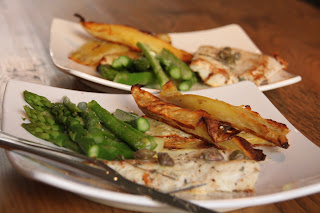Serves: 2
Since I found out my cholesterol was high, I have been trying to have
less red meat in my diet, and more veg, lean chicken and fish. So you
will see a lot of these types of recipes in the blog! Including more
fish has opened up a world of new delicious tastes, and I have been
trying new fish varieties every week. This recipe uses Kingklip, one of
South Africa's best loved fishes. Unfortunately I found out after buying
the fish that is it actually orange on the Sassi (Southern African
Sustainable Seafood Initiative) list (
www.wwfsassi.co.za<
http://www.wwfsassi.co.za>)
I do think we should all be aware of conservation in what we eat and
buy. Luckily this recipe will work just as nicely with any firm
white-fleshed fish. I was shocked to find that amongst the list of
orange fishes are hake, east-coast sole, prawns and yellowfin tuna!
I decided to include sweet potato in this recipe, perhaps a bit of an
odd choice, but it's one of my absolute favourite starches, and you just
can't beat it roasted! It's also lower GI than normal potatoes. I
thought the combination really worked, but you could also roast regular
potatoes, or serve with rice.
Ingredients:
- 2 medium or 1 large sweet potato
- Olive oil
- Salt
- 400g firm fleshed white fish, filleted
- 1 tablespoon fresh thyme
- 1 clove of garlic, crushed (if you like garlic!)
- 2 tablespoons lemon juice
- 2 tablespoons butter
- 2 tablespoons fresh cream (I used the reduced fat variety)
- Black pepper
- 8 Capers
- Green asparagus spears
Method:
- Preheat the oven to 190 degrees.
- Peel the sweet potatoes, and cut lengthways into 4. If very large, the
slices can be cut in half again. Place in hot water and microwave for 5
minutes, just to soften them before roasting. Then lay them in an oven
tray, coat with olive oil and a sprinkling of salt, and roast for about
45 minutes, until crispy and cooked through.
- Once the sweet potatoes are nearly done, heat some olive oil in a
non-stick pan and fry the fish fillets with the garlic and thyme. Cook
for about 3 minutes on each side, depending on the thickness, the fish
should come out slightly browned on both sides, and should form large
flakes. Do not let it dry out. Add the capers in the last minute of
cooking the fish.
- In the meantime, boil your asparagus for about 4 minutes in salted water, until they are starting to soften.
- Melt the butter, and then mix with the cream. Heat this lightly in the
microwave or a small pot. Just before serving, add the lemon juice and
black pepper.
- Plate up by placing the fish, asparagus and sweet potatoes neatly on a
dinner plate. Spoon the capers on top of the fish, and the sauce over
the fish and asparagus.






